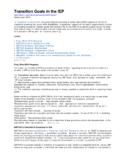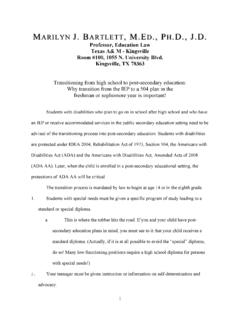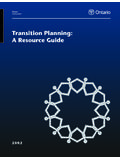Transcription of VB-MAPP Training Handout - Steven Celmer
1 VB-MAPP Training Program How to Interpret the Assessment 1 Presentation Handout VB-MAPP Training Handout How to Interpret the Assessment & Select IEP goals Purpose This Handout is designed to be a reference sheet for you when interpreting a VB-MAPP profile. It contains helpful tips for what to look for on each scoring form, as well as advice on how to select IEP goals based on the information in each scoring form. Additionally, this Handout also contains suggestions on making placement decisions based on the information included in the VB-MAPP scoring forms. The numbered bubbles on the example scoring forms indicate the area that each point under the What to look for section is referring to General Information - After the VB-MAPP has been completed for a student, most of the important information will be located on the three scoring forms: the Milestones, Barriers, and Transition - Remember that the Task Analyses Charts aren t to be used necessarily for determining goals , but are to be used to support the achievement of selected goals o The Task Analyses charts provide suggestions for learning objectives that can be used to support the learning of VB-MAPP based IEP goals - Remember that there are other sources of information that can help in developing and IEP and that the VB-MAPP should not be the only source of goals o OT s, SLP s, PT s, parents and others familiar with the student s abilities should also have input into what goals are selected for an IEP If you like this, then please see my other VB-MAPP Training materials at VB-MAPP Training Program How to Interpret the Assessment 2 Presentation Handout Milestones Scoring Form What to look for - On this form, there are four main things to make a note of: 1.
2 The general Level of the student, 2. Any gaps within each skill, 3. The student s relative weaknesses, 4. The student s relative strengths Using the Milestones for an IEP - The main goal in using the VB-MAPP to guide IEPs is to make sure that you have a student with a balanced skill set - Students relative weaknesses and any gaps that exist in a their profile should be focused on more heavily o For those skills where the student is weaker, you will want to choose 2 or 3 goals to help get that skill in balance with the others o For those skills where the student is stronger, you still want to make progress on them. But depending on the intensity of the IEP, maybe only 1 or 2 goals may be necessary for the current year o Remember that when selecting goals , you don t have to select the next immediate Milestone, but move 3 or 4 Milestones up to obtain an appropriate annual IEP goal - When choosing goals , goals should also be based on the student s current Level o Choose those that will help to fill out and complete a Level if the student is just beginning that Level o Choose those within the beginning of the next Level if the student is near completion of a Level - It is important to remember that Milestones don t have to be used verbatim, but added to in order to ensure that the student is making as much progress within the year as possible.
3 O The Milestones are just the minimum of what normally developing children do and children with disabilities need much more than that to be successful in the world VB-MAPP Training Program How to Interpret the Assessment 3 Presentation Handout 4 1 3 3 2 How to Interpret the Assessment Presentation Handout Page 3 VB-MAPP Training Program How to Interpret the Assessment 4 Presentation Handout Barriers Scoring Form What to look for - On this form, there are mainly two things to look for: 1. Any barrier that is given a score of 3 or 4 is considered a persistent or severe problem 2. Any barrier that is given a score of 2 or 1 is considered a moderate or occasional problem Using the Barriers for an IEP - Because significant Barriers can present a problem for multiple academic objectives, it is important to set IEP goals to reduce those that are persistent and severe o Making these a priority will pave the way for the achievement of the student s Milestones - Barriers that are identified as moderate or occasional may not necessarily need an IEP goal assigned to them, o But they are important to know and pay attention to so that you can prevent them from getting worse - Knowing the moderate and occasional barriers will help in.
4 O Differentiating instruction for the student s specific needs It lets you know where the students weak points are and therefore where extra accommodations may need to be made o Prioritizing academic goals for the student If there is a barrier and a lower corresponding Milestone score (like a low tact milestone score when there is a defective tact barrier), then you can make sure to make that goal a priority for the year VB-MAPP Training Program How to Interpret the Assessment 5 Presentation Handout 1 1 2 2 2 2 How to Interpret the Assessment 5 Presentation Handout VB-MAPP Training Program How to Interpret the Assessment 6 Presentation Handout Transition Scoring Form What to look for - There are essentially three sections to the form: 1. The 1st row contains information regarding language, social, & academic levels 2. The 2nd row contains information regarding learning patterns 3.
5 The 3rd row contains information regarding self-help skills, adaptability, & self-direction Using the Transition form for an IEP and Placement Decisions - The Transition form mainly provides information regarding appropriate program placement - The large range of information on the form can help point the IEP team to a general type of program - o Completely self-contained o Self-contained with some inclusion o Inclusive with pull-out o Inclusive with specific accommodations - It also provides information on individual accommodations that may be needed for specific settings o Such as a student that may be able to succeed in a more inclusive setting, but will need accommodations for toileting because of a low score - While the Transition form does inform placement decisions, remember that IEP goals can be selected from it too (such as for self-help deficits or transition issues) - The 1st section of the form is the most important because it will tell us if the student s skill level is high enough to keep up with the material that is presented in various settings o If the student s skills aren t strong enough for a proposed setting, then a different setting that would better meet the student at his level should be considered - The 2nd section of the form provides the most information on how successful the student might be at different levels of inclusion o If scores are higher across these categories, the student may be more successful in more inclusive settings o If they are lower, then a more supportive setting with individualized instruction will necessary for academic success - This 3rd section also plays a role in determining how restrictive a setting is needed for a student s success, but to a lesser extent o It focuses more on behaviors that aren t directly taught in school.
6 But may cause a problem if they aren t in the student s skill set o The information here may not completely rule out a proposed setting, but may indicate that accommodations need to be made to allow the child to fully access that less restrictive setting VB-MAPP Training Program How to Interpret the Assessment 7 Presentation Handout 1 2 3 How to Interpret the Assessment 7 Presentation Handout







